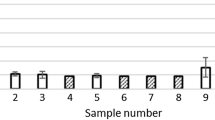Abstract
Brazilian and Chinese eye shadow powders were evaluated for assessing the cosmetics as a source of contamination during sample preparation of biological materials. Nineteen chemical elements were measured by INAA. Highest mass fractions measured were for Ba (~ 2.5%), Cr (~ 1%), Fe (~ 45%), Na (~ 10%) and Sn (~ 1). It was experimentally verified that more than 0.01 mg of eye shadow may drop off and as such may be a potential source of contamination, causing high relative errors depending on the type of biological matrices and chemical element considered.

Similar content being viewed by others
References
Versieck A, Cornelis R (1989) Trace elements in human plasma and serum. CRC Press, Boca Raton
Draelos ZD (2001) Special considerations in eye cosmetics. Clin Dermatol 19:424–430
U.S. FDA. Part 73 (2018) https://www.ecfr.gov/cgi-bin/text-idx?c=ecfr&SID=fc2869830da702969a2dcfdeb71d7594&rgn=div5&view=text&node=21:1.0.1.1.27&idno=21#21:1.0.1.1.27.3. Accessed 11 May 2018
Council Directive 76/768/EEC (1976) https://eur-ex.europa.eu/LexUriServ/LexUriServ.do?uri=CONSLEG:1976L0768:20100301:en:PDF. Accessed 15 May 2018
ANVISA—Brazilian Health Regulatory Agency (2012) http://portal.anvisa.gov.br/documents/10181/3285555/RDC_44_2012_.pdf/a2489836-8233-40bc-b880-c7719ae356fc. Accessed 15 May 2018
Hepp NM, Mindak WR, Gasper JW, Thompson CB, Barrows JN (2014) Survey of cosmetics for arsenic, cadmium, cobalt, lead, mercury and nickel content. J Cosmet Sci 63:125–145
Sneyers L, Verheyen L, Vermaercke P, Bruggeman M (2009) Trace element determination in beauty products by k0-instrumental neutron activation analysis. J Radioanal Nucl Chem 281:259–263
Bruzzoniti MC, Abollino O, Pazzi M, Rivoira L, Giacomino A, Vincenti M (2017) Chromium, nickel, and cobalt in cosmetic matrices: an integrated bioanalytical characterization through total content, bioaccessibility, and Cr(III)/Cr(VI) speciation. Anal Bioanal Chem 409:6831–6841
Kanias GD (1984) Determination of trace elements in eyeshadow face powder and rouge make-up cosmetics by neutron activation analysis. J Radioanal Nucl Chem 89:487–496
Furuta E, Nakahara H, Hatsukawa Y, Matsue H, Sakane H (2008) Neutron activation analysis of trace elements in Japanese hormesis cosmetics. J Radioanal Nucl Chem 278:553–557
Sainio EL, Jolanki R, Hakala E, Kanerva L (2000) Metals and arsenic in eye shadow. Contact Dermat 45:5–10
Atz VL (2008) Desenvolvimento de métodos para determinação de elementos traço em sombra para olhos e batom. Master Dissertation. Universidade Federal do Rio Grande do Sul. Porto Alegre, Brazil
Atz VL, Pozebon D (2009) Graphite furnace atomic absorption spectrometry (GFAAS) methodology for trace element determination in eye shadow and lipstick. At Spectrosc 30:82–91
Melquiades FL, Parreira PS, Endo LY, Santos G, Wouk L, Filho OP (2015) Portable EDXRF for quality assurance of cosmetics. Cosmetics 2:277–285
Santos BV, Júnior JMO, Júnior WB, Hanai-Yoshida VM (2018) Assessment of chemical elements in cosmetics’ eye shadows by X-ray fluorescence and international nomenclature of cosmetic ingredients characterization. X-ray Spectrom 47:242–251
Barros AI, Silva TV, Ferreira EC, Neto JAG (2015) Determination of lead in eye shadow and blush by high-resolution continuum source graphite furnace atomic absorption spectrometry employing direct solid sampling. J Braz Chem Soc 26:140–146
Volpe MG, Nazzaro M, Coppola R, Rapuano F, Aquino RP (2012) Determination and assessment of selected heavy metals in eye shadow cosmetics from China, Italy, and USA. Microchem J 101:65–69
Dalmázio I, Menezes MABC (2011) Multi-elemental profile of some Brazilian make-up products by instrumental neutron activation analysis. In: Proceedings of the international nuclear Atlantic conference—INAC 2011, Belo Horizonte, MG, Brazil
França EJ, Fernandes EAN, Bacchi MA (2003) Ni–Cr alloy as neutron flux monitor: composition and homogeneity assessment by NAA. J Radioanal Nucl Chem 257:113–115
Bacchi MA, Fernandes EAN, Oliveira H (2000) A Brazilian experience on k0 standardized neutron activation analysis. J Radioanal Nucl Chem 245:109–114
Bacchi MA, Fernandes EAN (2003) Quantu—design and development of a software package dedicates to k0-standardized INAA. J Radioanal Nucl Chem 257:577–582
Elias C, Fernandes EAN, Bacchi MA (2012) Neutron activation analysis for assessing chemical composition of dry dog food. J Radioanal Nucl Chem 291:245–250
Kato LS, Fernandes EAN, Bacchi MA, Elias C, Sarriés SRV, Sarriés GA, Modolo PS (2013) Instrumental neutron activation analysis for assessing homogeneity of a whole rice candidate reference material. J Radioanal Nucl Chem 297:271–275
Turra C, Fernandes EAN, Bacchi MA, Tagliaferro FS, França EJ (2006) Differences between elemental composition of orange juices and leaves from organics and conventional production systems. J Radioanal Nucl Chem 270:203–208
Bacchi MA, Fernandes EAN, Tsai SM, Santos LGC (2003) Conventional and organic potatoes: assessment of elemental composition using k0-INAA. J Radioanal Nucl Chem 259:421–424
Acknowledgements
The authors are thankful to the Radioisotopes Laboratory, Nuclear Energy Centre for Agriculture, University of São Paulo, for providing financial support for this research.
Author information
Authors and Affiliations
Corresponding author
Rights and permissions
About this article
Cite this article
da Silva, G., De Nadai Fernandes, E.A., Bacchi, M.A. et al. Ban the beauty in trace element laboratories: contamination risks of eye shadow. J Radioanal Nucl Chem 318, 761–765 (2018). https://doi.org/10.1007/s10967-018-6158-9
Received:
Published:
Issue Date:
DOI: https://doi.org/10.1007/s10967-018-6158-9




